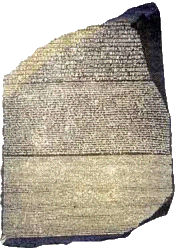
icon - Loosely,
a picture; a sculpture,
or even a building, when regarded as an object
of veneration.
Examples of icons in this first sense:

Egypt, 203 BCE,
Rosetta
Stone, a slab of granite,
3 feet 9 inches x 2 feet 4 inches wide x 11 inches thick (118
x 77cm), the remains of a stele
inscribed in three scripts: hieroglyphic, later Egyptian demotic
-- a cursive form of ancient Egyptian, and ancient Greek. Each
of these three scripts were being used in Egypt at the time it
was carved. An officer of Napoleon's engineering corps found
the stone half buried in the mud near Rosetta, a city near Alexandria,
in 1799. Carved on the
stone is a decree by Egyptian
priests to commemorate the
crowning of Ptolemy V Epiphanes, king of Egypt from 203 - 181
BCE
The Stone is an icon of
script and decipherment.


Frederic Auguste Bartholdi (French, 1834-1904),
Liberty Enlightening the World, "The Statue of Liberty",
presented to the United States by France, dedicated in 1886,
height 119 feet from feet to crown,
 on
a small island in the harbor of New York City.
on
a small island in the harbor of New York City.

Coca Cola advertising
sign, 20th century, enamel on steel. See circle
and logo.
Andy Warhol (American, 1928-1987), Green Coca-Cola Bottles, 1962, oil on canvas, 82 1/2 x 57 inches (209.6 x 144.8 cm), Whitney Museum of American Art, NY. Warhol often depicted iconic subjects, as did other painters of Pop Art.
Jasper Johns (American, 1930-), White Flag, 1955, encaustic, oil, newsprint and charcoal on canvas, 78 3/8 x 120 3/4 inches (198.9 x 306.7 cm), Metropolitan Museum of Art, NY. See flag and Pop Art.
Also, a simile or symbol.
In semiotics, as presented by Charles Sanders Peirce (American pragmatist, 1839-1914; pr. purse), an icon is one of three kinds of signs: icon, index and symbol. Whether a sign belongs in one category or another is dependent upon the nature of its relationship between the sign itself (which he called the referent) and the actual meaning. An icon is a meaning which is based upon similarity or appearance (for example, similarity in shape). According to Pierce, icons are "the only means of directly communicating an idea." An index is a meaning based upon some cause and effect relationship (for example, a thermometer carries certain meaning because of variation in temperature): "Because the indexical sign is understood to be connected to the real object, it is capable of making that object conceptually present."
Thirdly, in churches of the Eastern Rites, a panel painted with a representation of a sacred or sanctified Christian personage, and an object of veneration.
Examples in the third sense:
Coptic Egypt, Painting of Christ Protecting Abbot Mena, 6th-7th century, painted wood, 57 x 57 x 2 cm, Louvre. See Coptic art and votive.

Byzantine (Constantinople or Sinai?), second
half of the 13th century, Icon with the Archangel Gabriel, tempera and gold on wood
panel with raised borders, 105
x 75 cm (41 3/8 x 29 1/2 inches), Holy Monastery of Saint Catherine,
Sinai, Egypt. One of the masterpieces
of Byzantine
art, this icon
shows the archangel Gabriel as a youth of extreme beauty. His graceful posture and harmonious
gestures, along with the
calmness of his face, are evocative of classical
art. The figure
wears a light green tunic and a himation
covered with golden highlights.
According to the eleventh-century writer Michael Psellos, a fillet
such as that around the curly hair signifies the purity, chastity,
and incorruptibility of the angels. Gabriel's function as a messenger
is indicated by the walking staff he holds in his left hand,
while he makes a gesture of adoration and supplication with his
right hand. This icon was part of a larger group, very
likely forming a deesis.

Russia, Novgorod School, St. Nicholas, late 13th-early 14th century,
egg tempera on gesso,
linen, wood, 107.7 x 79.5 cm,
Hermitage Museum, St. Petersburg, Russia. See Russian
art.
Russia, Northern School, Christ the Almighty, second half of the 13th-14th century, egg tempera on gesso, wood, 65.5 x 41.5 cm, Hermitage Museum, St. Petersburg, Russia.

Byzantium, The Cambrai Madonna, c. 1340, Metropolitan
Museum of Art. About a hundred years after it was produced, Canon
Fursy de Bruille acquired this icon in Rome. He was told that
it was a holy relic: it
had been painted by St. Luke himself. In 1440, the canon gave
the painting to the Cathedral of Cambrai, France, where thousands
of pilgrims saw it. The image
shows Jesus squirming in his mother's arms. Mother and child,
doleful and shy, turn slightly toward us, as if they are watching
or waiting for something. The Cambrai Madonna conforms to a type,
"the Virgin of Tenderness," an invention of the late
Byzantine era. See Byzantine
art and Madonna.
![]()
Byzantium, Christ Pantocrator, 1363, egg
tempera on gesso, wood, Hermitage Museum, St. Petersburg,
Russia. This icon was created for the Monastery of the Pantocrator
on Mount Athos. It is a characteristic work from the last high
period of Constantinople painting, the late 14th and early 15th
centuries. See Byzantine
art.
Byzantine, Macedoma, Icon of the Anastasis, third quarter of the fourteenth century, tempera on wood, 14 3/16 x 10 7/16 inches (36 x 26.5 cm), Walters Art Gallery, Baltimore, MD.

Russia, Novgorod School, The Annunciation, double-sided tablet
icon, late 15th-16th century, egg
tempera on gesso, linen,
wood, gilding,
22.8 x 17.5 cm, Hermitage Museum, St. Petersburg, Russia. See
Russian art.

Russia, Moscow School (?), The Nativity, 16th century, egg
tempera on gesso, linen,
wood, 56 x 44.5 cm, Hermitage
Museum, St. Petersburg, Russia.

Nektary Kulyuksin (Workshop of the Kirillo-Byelozersk
Monastery, Archangel, Russia), St. John the Divine in Silence, 1679,
egg tempera on gesso,
linen, wood, 158.5 x 60.5 cm,
Hermitage Museum, St. Petersburg, Russia.

Russia, Icon of Christ Pantokrator, 19th century,
oil on wood panel,
3 1/2 x 2 5/8 inches, Minneapolis Institute of Arts.
![]()
Ovchinnikov Manufactory, Moscow, Icon of Saints Alexander Nevsky, Titus and Polycarpus,
1879, tempera on wood
panel, silver,
enamel, gilt,
diamonds, pearls, 128 x 55 cm, Hermitage Museum, St. Petersburg,
Russia.
![]()
Ivan Khlebnikov factory, Moscow, Three-Part Icon of Our Lady of Bogolyubsk,
with Saints Alexander Nevsky and Mary Magdalene, 1882, tempera
on wood panel,
silver, enamel, 54 x 49.2 cm, Hermitage Museum, St.
Petersburg, Russia. See Russian art.
![]()
A. I. Tsepkov, St. Nicholas the Miracle Worker and St. Tsarina
Alexandra, icon, 1898, wood,
tempera, gilt,
Hermitage Museum, St. Petersburg, Russia.
Also, an icon can be a person who is the object of great attention and devotion; an idol.
And, in computer jargon, an icon is a picture on a monitor's screen that represents a specific command or a piece of software.
A rare alternative spelling is ikon.
Iconism is the worship of images.
See articles about numerous words formed with the prefix icono-:
Also see aniconic, font, glyph, heraldry, hieroglyphics, iconoclast, iconoduly, iconodulic, iconodulist, iconography, iconolater, iconolatry, iconology, iconomach, iconomachy, iconomania, iconophile, iconophor, ideogram, lettering, logo, petroglyph, pictograph, plaque, taxis, text, typography, and votive.
https://inform.quest/_art